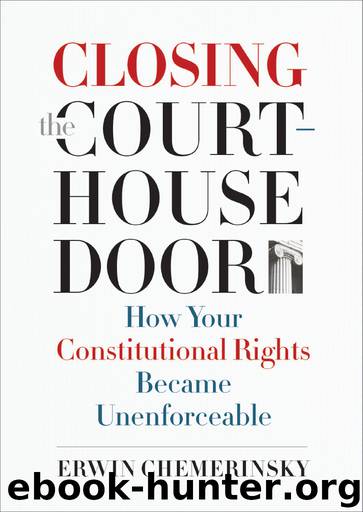Closing the Courthouse Door by Erwin Chemerinsky

Author:Erwin Chemerinsky [Chemerinsky, Erwin]
Language: eng
Format: epub
Publisher: Yale University Press
Published: 2016-04-14T04:00:00+00:00
FIVE
The Great Writ
How Habeas Corpus Has Been Suspended
On November 4, 1995, Leandro Andrade, a nine-year Army veteran and father of three, was caught shoplifting five children’s videotapes worth a total of $84.70 from a K-Mart in Ontario, California. The store’s loss prevention officer observed his actions, stopped him, and confiscated the tapes. Andrade was arrested for shoplifting.
Two weeks later, on November 18, 1995, Andrade went to a different K-Mart, in Montclair, California, and was caught shoplifting four children’s videotapes worth $68.84. Again, security observed Andrade on store video cameras, stopped him, confiscated the tapes, and arrested him for shoplifting.
Under California law, each crime by itself would be regarded as a petty theft,1 a misdemeanor punishable by a fine, a jail sentence of six months or less, or both.2 But California law also provides that petty theft with a prior conviction for a property offense is a felony.3
Andrade had been a drug addict while in the Army. After his discharge he committed a series of minor property crimes, including shoplifting. His most serious offenses were in 1983, twelve years before his K-Mart thefts, when he robbed three houses on the same day. He was unarmed, and in no instance was anyone home. He was caught, convicted of burglary, and sentenced to two and a half years in prison, which he served. Because of those convictions, Andrade’s shoplifting was charged as the felony crime of petty theft with a prior.4
The way California’s sentencing structure works, two counts of petty theft with a prior is punishable by a maximum of three years and eight months in prison.5 That would have been a significant punishment for stealing $153 worth of children’s videotapes.
But that is not what Andrade got as a punishment. In 1994, California adopted a law called “three strikes and you’re out.”6 The three strikes law mandates a sentence of twenty-five years to life upon a defendant’s third felony conviction.7 It requires that the first two felonies be “serious” or “violent,”8 but at the time of Andrade’s trial, the third strike could be any crime, however minor.9 Andrade, convicted of two counts of petty theft with a prior, was sentenced to two consecutive sentences of twenty-five years to life imprisonment.10 His sentence, properly phrased, was an indeterminate life sentence with no possibility of parole for fifty years.11 Thirty-seven years old when he was convicted in 1996, he would become eligible for parole in 2046, at the age of eighty-seven.12
Andrade’s sentence was not unique. At the time of his appeal, 344 individuals were serving sentences of twenty-five to life or more for shoplifting—for petty theft with a prior—under California’s three strikes law.13 Hundreds more were serving life sentences for possessing small quantities of drugs.
The California Court of Appeal affirmed the judgment against Andrade, finding that the sentence did not violate the Eighth Amendment’s prohibition of cruel and unusual punishment.14 The California Supreme Court denied review.15
Andrade, on his own, then filed a timely habeas corpus petition in the United States District Court for the Central District of California.
Download
This site does not store any files on its server. We only index and link to content provided by other sites. Please contact the content providers to delete copyright contents if any and email us, we'll remove relevant links or contents immediately.
Day by Elie Wiesel(2596)
The Age of Genius by A. C. Grayling(2393)
Gideon's Spies: The Secret History of the Mossad by Gordon Thomas(2238)
The Gulag Archipelago (Vintage Classics) by Aleksandr Solzhenitsyn(1987)
FATWA: Hunted in America by Pamela Geller(1927)
Columbine by Dave Cullen(1767)
Men Explain Things to Me by Rebecca Solnit(1609)
The Rule of Law by Bingham Tom(1594)
Examples & Explanations: Administrative Law by William F. Funk & Richard H. Seamon(1553)
Anatomy of Injustice by Raymond Bonner(1532)
Three Cups of Tea by Greg Mortenson(1519)
That Every Man Be Armed by Stephen P. Halbrook(1480)
ADHD on Trial by Michael Gordon(1474)
The Source by James A. Michener(1459)
Gideon's Spies by Gordon Thomas(1425)
Future Design by Unknown(1386)
Palestinian Walks by Raja Shehadeh(1363)
Constitutional Theory by Carl Schmitt(1347)
Fast Times in Palestine by Pamela Olson(1335)
